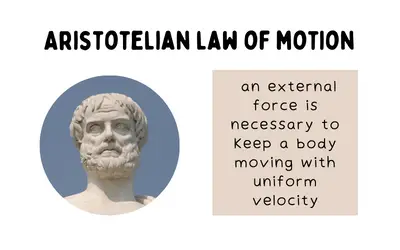

On this page we will learn about what is force and effects produced by a force, and our second topic of discussion would be Aristotle’s fallacy.
Let us now begin our discussion by first defining force and revising in brief about the effects produced by a force.
Force may be defined as an effect mainly push or a pull which changes or tends to change the state of rest or of uniform motion or the direction of motion of a body.
Now from this definition you can easily guess the effects force producers when it acts on a body.
So, when a force is acting on a body or an object it can produce three types of changes.
What we mean by this statement is that if you want to change the speed of a moving object maybe you want to increase the speed of the moving object or you want to decrease the speed of the moving object. You can achieve this objective by applying force on the moving object.
For example let us consider a horse pulling a cart now initially if this cart is at rest, then if you want to move it horse would have to exert a force to pull it from rest. Now if you want to increase the speed of this cart the horse would have to exert an additional amount of force so that the cart could move with a larger speed.
Let s take another example of a moving car. Now suppose the driver of a car wants to lower the speed of the car. In this case force exerted by brakes slows down the car and eventually a greater amount of force can be exerted by the brakes in order to stop the moving car.
For example of this type of effect of force could be the steering wheel off a car. By moving the steering wheel of the car, we can change the direction of motion of the car.
For example if you hold a rubber band in your hands and start to stretch it by pulling it in two different directions then it would get stretched and hence would no longer be in its original shape until and unless we release the force that is being applied to both its ends.


Before having a discussion about Aristotle’s Fallacy let us first understand the word Fallacy. Meaning of word Fallacy is an idea that a lot of people think is true but is in fact false.
In the construction of an argument, a fallacy is the use of invalid or otherwise flawed logic. A misleading fallacious argument can sometimes appear to be stronger than it really is.
Some fallacies are purposefully committed to deceive or are justified by manipulation, while others are unintentionally committed due to carelessness or ignorance.
Now that you know about the meaning of word fallacy let us now move to our main topic which is Aristotle’s Fallacy.
Every day, you might witness a lot of objects under motion. Infect you yourself can put objects in state of motion. Let's say you push a toy truck and it starts to move or you are spinning top on the floor. What do you notice after some time? After spinning or moving for a while, the toy come to rest. This is giving rise to a question. Is it necessary to have an external force to keep the body in uniform motion?
The natural state of a body, according to the Greek philosopher who lived from 384 BC to 329 BC, is rest. According to him every moving object slows down and eventually it comes to rest.
Maintaining the motion of a moving body generally requires the application of an external force. To keep the toy truck moving in our example, for example, it must be pushed constantly.
Similarly, a cart on the road has to be pushed constantly to keep it in motion. It won't get very far with just one push. Aristotle concluded from such observations that
Aristotle’s Law of Motion:- An external force is necessary to keep a body with moving with uniform speed.
This law of motion presented by Aristotle is also known as Aristotle’s Fallacy.
Galileo, about 2000 years later, contradicted Aristotle's arguments on motion. Let us now look at why Aristotle's observation is considered a fallacy.
A moving toy truck from our example is known to come to a rest after some time. However, the presence of the frictional force that the toy truck experiences as a result of its contact with the floor is the true reason behind its halt.
We know that Frictional forces opposes its motion and eventually causes it to come to a rest. So now, when you apply force in the direction of the toy truck’s motion, you're basically overcoming or counteracting the frictional force and getting the toy truck to move again.
It's worth noting that if there had been no frictional force, no force would have been required to keep the toy truck moving. This means that in the absence of an external opposing force, a moving body will continue to move in the same direction indefinitely(See law of inertia).
Aristotle misunderstood this and based his argument solely on his own personal experiences. Aristotle's fallacy gets its name from this.
So, we can conclude from this article that Resistive or frictional forces, on the other hand, are always present in the natural world. As a result, we will require external assistance to overcome these forces.